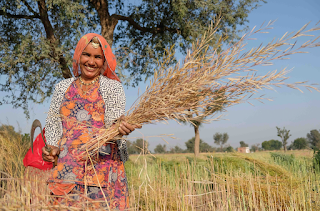In a stimulating conversation with Thrive, J.P. Tripathi – DGM and vertical head for Agriculture at Ambuja Cement Foundation reveals the most significant risks to agricultural livelihoods in India and how ACF has been addressing these risks.
Timely Information
The biggest risk to farming in India is weather. Weather conditions lie at the root of a myriad of risks that the farmer takes to achieve a profitable harvest. The whole investment process, dependent on this one factor, is risk prone and the farmer has little control over price fluctuations in the context of inputs and output. The only data he bases his production on is the previous year’s harvest rather than any concrete scientific data including crop, weather, and market trends for the current year. While this data is collated at a national level, it is usually not available to the farmer. This is where enabling the farmer with an early assessment of the crop season becomes crucial to make informed decisions. Suppose the trend suggests that there is going to be a 20% increase in the total production area of onion, implying that its prices will fall in harvest season and an excess crop will depress it further, the farmer can then choose not to sow the onion crop and shift to another crop which may fetch more returns.
Financing
The second area of risk is financing. The farmer never has the resources to fund his investment in totality and must depend on external funders. This external funder is usually a middleman who lends at unreasonable rates. While NBFCs such as microfinance institutions are also present in Rural India, interest rates are significantly high and range between 15 -27%.
To counter this, any approach to reduce the farmer’s risk needs to look at boosting income such that he has the resources to fund his crop cultivation. This may be achieved through diversifying his income streams through means like multi-cropping or growing fruits and vegetables, or various components of animal husbandry.
In the recent past, several small finance banks have initiated operations, but unfortunately their focus has been on the urban poor in towns and cities. There is huge potential in rural India which is hitherto untapped, and it will be a win-win if farmers can gain access to loans with lesser documentary requirements.
Insurance
Unlike the plethora of insurance products available for assets in the cities, assets that farmers own are often uninsured. Livestock, ponds, fields are commonly not protected by insurance, causing irreparable losses in the face of adverse situations. Insurance products for these livelihood assets are a necessity but not easily available. Even if available, they are usually unaffordable to the farmer as scaling up the product may not be viable to the insurance company.
Assessment and settlement of claims is another area which is considerably bothersome to the farmer today. The Government should look at stepping in to ensure that this process is smoothened. A scientific model may be evaluated where the farmer can be paid a settlement automatically without even registering a claim. Technologies such as GPS and other satellites-based assessments are helping the government take futuristic decisions such as the recent announcement of not having to pay tolls at toll booths instead having it directly deducted from the individual’s bank account. Similarly, if farmers can be compensated for losses incurred, it will act as a big morale booster to the sector with farmers knowing that the system is backing them in their endeavors.
How ACF addresses these risks and increases farmer productivity
Creating a conducive environment for farmer empowerment is imperative to enabling prosperity for them. While ACF continuously works to build capacity for farmers through field visits and now virtual means to educate them and apprise them of pertinent rends, it has also been encouraging them to diversify crop production. The results can be seen now. Over 27000 farmers engage in some form of livestock farming including goat rearing, milk production, horticulture and vegetable and fruit production. ACF has also been actively encouraging intercropping from a livelihoods perspective and are seeing farmers gain from growing crops such as cauliflower in between the cotton crops.
SHGs and FPOs supported by ACF have mobilised more than Rs. 3.5 crores to farmers requiring financial assistance for purchase of inputs in the ongoing pandemic. The Self-Help Groups have been instrumental in raising funds from the banks and providing aid to those in need. ACF prides itself in this very multipronged approach where it enables rural households by enabling the farmer, the women, and the youth. At the household level, ACF works to ensure that there are savings, viable financial support, and multiple income streams. In this way, ACF secures the risks of finance and production. Insurance remains a challenge and there are structural issues which can only be addressed by the government. However, ACF has encouraged over 30000 farmers to apply for the COVID-19 insurance to date.
To learn more about ACF’s work or invest in a Corporate Social Responsibility project in Agriculture, reach out to J.P. Tripathi at rajesh.suthar.ext@ambujafoundation.com







0 Comment